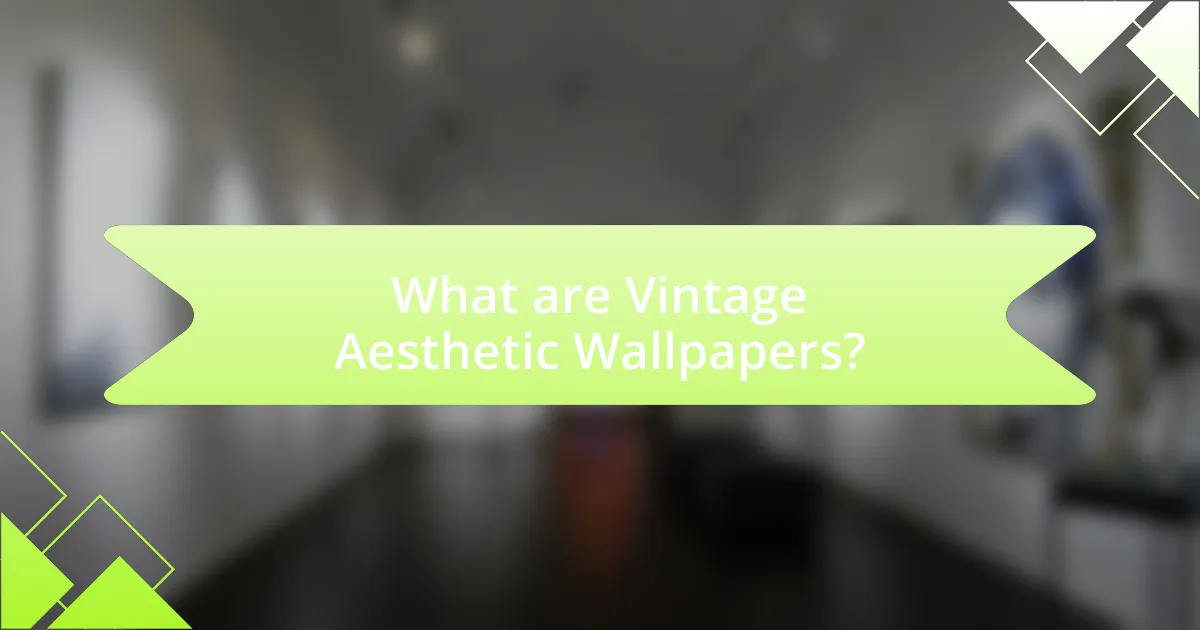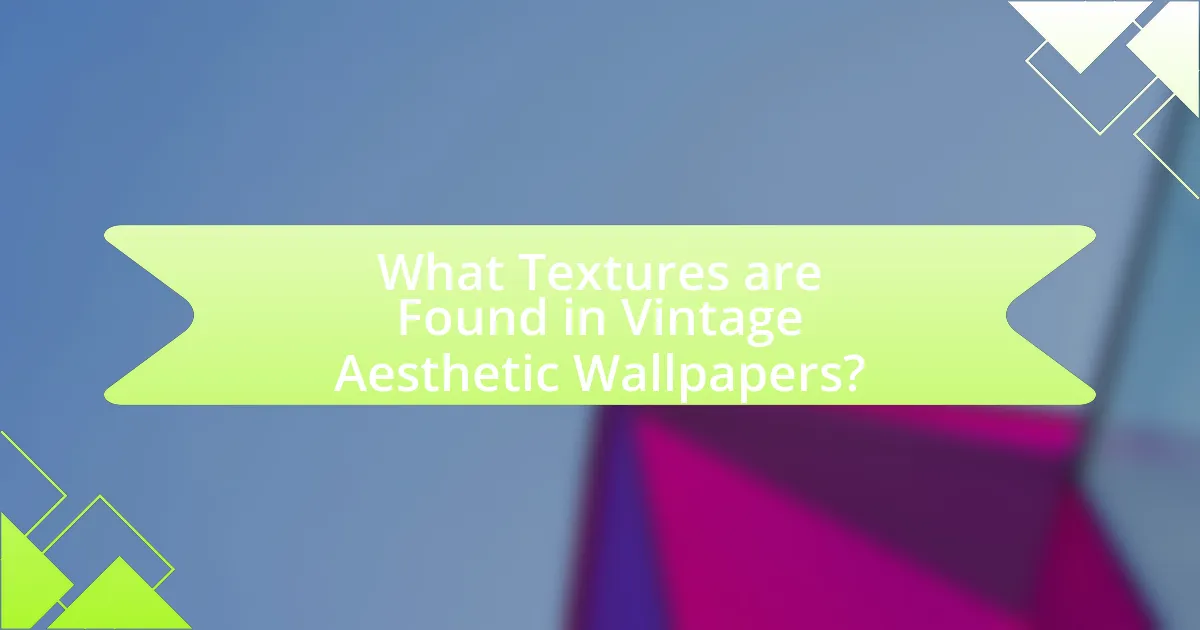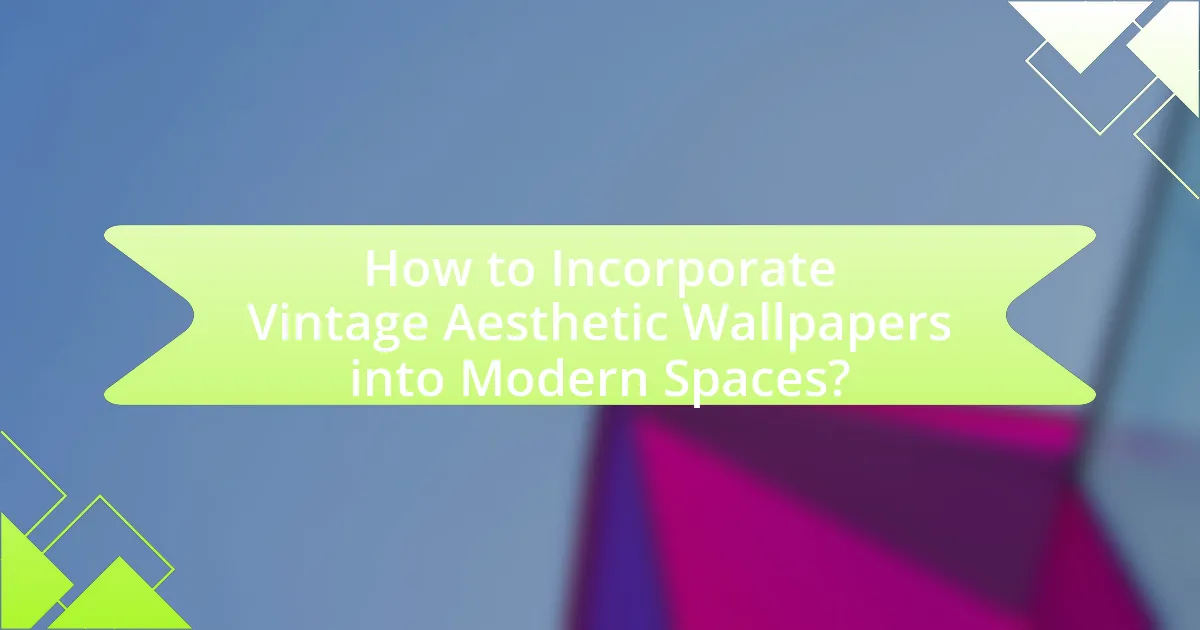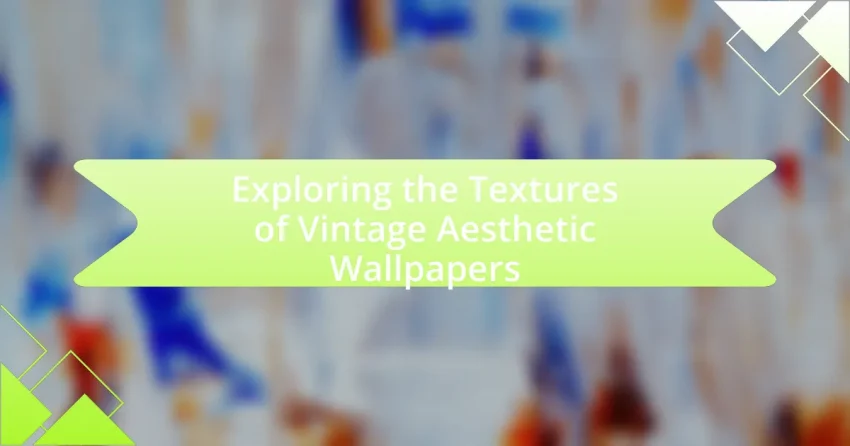Vintage aesthetic wallpapers are decorative wall coverings that draw inspiration from designs of past eras, particularly from the late 19th to mid-20th century. This article explores the characteristics of vintage wallpapers, including their distinct color palettes, historical influences, and common materials used in their production. It also examines the role of texture in enhancing the visual and tactile appeal of these wallpapers, as well as the environmental impacts of sourcing materials. Additionally, the article provides insights on incorporating vintage wallpapers into modern spaces, maintenance practices, and common mistakes to avoid, making it a comprehensive resource for understanding the significance and application of vintage aesthetic wallpapers in contemporary design.

What are Vintage Aesthetic Wallpapers?
Vintage aesthetic wallpapers are decorative wall coverings that evoke a sense of nostalgia through designs and patterns reminiscent of past eras, particularly from the late 19th to mid-20th century. These wallpapers often feature floral motifs, intricate damasks, and retro color palettes that reflect historical design trends. The appeal of vintage aesthetic wallpapers lies in their ability to create a warm, inviting atmosphere while showcasing artistic styles that have stood the test of time, such as Art Deco and Victorian influences.
How do Vintage Aesthetic Wallpapers differ from modern designs?
Vintage aesthetic wallpapers differ from modern designs primarily in their color palettes, patterns, and textures. Vintage wallpapers often feature muted, earthy tones and intricate, ornate patterns that evoke nostalgia, while modern designs typically utilize bold colors and minimalistic patterns aimed at a contemporary aesthetic. For instance, vintage styles may include floral motifs or damask patterns, which were prevalent in the 18th and 19th centuries, whereas modern wallpapers often embrace geometric shapes and abstract designs that reflect current design trends. This distinction highlights the contrasting influences of historical context versus contemporary simplicity in wallpaper design.
What historical influences shape Vintage Aesthetic Wallpapers?
Vintage aesthetic wallpapers are shaped by historical influences such as the Arts and Crafts Movement, Art Nouveau, and mid-20th century design trends. The Arts and Crafts Movement, which emerged in the late 19th century, emphasized handcrafted quality and natural motifs, leading to wallpapers that featured intricate floral patterns and earthy colors. Art Nouveau, popular from the 1890s to the early 1900s, introduced flowing lines and organic forms, influencing wallpaper designs with its emphasis on nature and elegance. Additionally, mid-20th century design trends, including the use of bold colors and geometric patterns, further diversified vintage wallpaper aesthetics, reflecting the cultural shifts of the post-war era. These movements collectively contribute to the rich tapestry of vintage aesthetic wallpapers, making them a reflection of their historical contexts.
How do color palettes contribute to the vintage aesthetic?
Color palettes significantly contribute to the vintage aesthetic by evoking nostalgia through specific hues and combinations that reflect past eras. These palettes often feature muted tones, such as faded pastels or earthy shades, which mimic the natural aging process of materials and designs from earlier times. For instance, the use of sepia tones and soft greens can transport viewers to the 1970s or 1980s, creating an emotional connection to those periods. Historical design trends, such as Art Deco or Mid-Century Modern, also influence color choices, reinforcing the vintage feel by aligning with the visual language of those times.
What are the common materials used in Vintage Aesthetic Wallpapers?
Common materials used in Vintage Aesthetic Wallpapers include paper, vinyl, and fabric. Paper wallpapers, often featuring intricate designs and patterns, were widely used in the 19th and early 20th centuries, reflecting the artistic styles of those eras. Vinyl wallpapers, introduced later, offer durability and ease of cleaning while still allowing for vintage designs. Fabric wallpapers, such as silk or linen, provide a luxurious texture and were popular in high-end applications. These materials contribute to the overall aesthetic and tactile experience of vintage wallpapers, making them sought after for their historical and decorative value.
How does texture play a role in the appeal of these wallpapers?
Texture significantly enhances the appeal of vintage aesthetic wallpapers by adding depth and tactile interest. The varied textures, such as embossed patterns or woven finishes, create visual intrigue and evoke a sense of nostalgia, which is a key element in vintage design. Research indicates that textured surfaces can influence emotional responses, making spaces feel warmer and more inviting. For instance, a study published in the Journal of Environmental Psychology found that textured materials can enhance the perception of comfort in interior spaces, reinforcing the allure of vintage wallpapers that often feature intricate textures.
What are the environmental impacts of sourcing materials for vintage wallpapers?
Sourcing materials for vintage wallpapers can lead to significant environmental impacts, primarily due to deforestation, chemical pollution, and resource depletion. The extraction of raw materials, such as wood pulp for paper and dyes, often results in habitat destruction and loss of biodiversity. For instance, the production of wood pulp can contribute to the clearing of forests, which are crucial for carbon sequestration and maintaining ecological balance. Additionally, the manufacturing processes may involve harmful chemicals that can contaminate water sources and soil, posing risks to both human health and local ecosystems. Studies indicate that the wallpaper industry has historically relied on non-sustainable practices, further exacerbating these environmental issues.
Why are Vintage Aesthetic Wallpapers popular in contemporary design?
Vintage aesthetic wallpapers are popular in contemporary design due to their ability to evoke nostalgia and create a unique, warm atmosphere in spaces. This popularity stems from a growing trend towards personalization in interior design, where individuals seek to express their identity through distinctive decor. The resurgence of vintage styles aligns with the broader movement towards sustainability, as many vintage wallpapers are made from eco-friendly materials and promote the reuse of resources. Additionally, the intricate patterns and textures found in vintage wallpapers offer a contrast to the minimalism prevalent in modern design, providing depth and character to interiors.
How do these wallpapers enhance interior spaces?
Vintage aesthetic wallpapers enhance interior spaces by adding depth, character, and a sense of nostalgia. These wallpapers often feature intricate patterns and textures that can transform a plain wall into a focal point, creating visual interest and evoking emotional responses. For instance, studies show that textured surfaces can influence mood and perception, making spaces feel warmer and more inviting. Additionally, vintage designs can complement various decor styles, from rustic to modern, thereby increasing the versatility of interior design options.
What trends are emerging in the use of vintage wallpapers today?
Emerging trends in the use of vintage wallpapers today include a resurgence in bold patterns, eco-friendly materials, and a focus on personalization in interior design. Homeowners and designers are increasingly drawn to vibrant floral and geometric designs reminiscent of the 1960s and 1970s, reflecting a desire for nostalgia and individuality in living spaces. Additionally, the use of sustainable materials, such as recycled paper and non-toxic inks, is gaining traction as consumers become more environmentally conscious. This shift is supported by a growing market for vintage-inspired wallpapers, with sales increasing by 15% annually, indicating a strong consumer preference for unique, character-rich designs that tell a story.

What Textures are Found in Vintage Aesthetic Wallpapers?
Vintage aesthetic wallpapers typically feature textures such as linen, silk, and embossed patterns. These textures evoke a sense of nostalgia and authenticity, often reflecting the craftsmanship of earlier design eras. Linen textures provide a natural, woven appearance, while silk textures add a luxurious sheen. Embossed patterns create a three-dimensional effect, enhancing visual interest and depth. Historical examples include the use of damask and brocade patterns, which were popular in the 18th and 19th centuries, showcasing intricate designs that highlight the tactile quality of the wallpaper.
How do different textures affect the overall aesthetic?
Different textures significantly influence the overall aesthetic by adding depth, contrast, and visual interest to a design. For instance, smooth textures can create a sleek and modern appearance, while rough textures evoke a sense of warmth and nostalgia, often associated with vintage aesthetics. Research indicates that tactile qualities can enhance emotional responses; a study published in the Journal of Environmental Psychology found that varied textures can affect perceptions of comfort and style in interior spaces. Thus, the choice of texture plays a crucial role in shaping the viewer’s experience and interpretation of a vintage aesthetic wallpaper.
What are the most common textures used in vintage wallpapers?
The most common textures used in vintage wallpapers include linen, silk, and embossed patterns. Linen textures provide a natural, woven appearance that was popular in the mid-20th century, while silk textures offer a luxurious sheen and smooth feel, often seen in Victorian-era designs. Embossed patterns create a three-dimensional effect, adding depth and tactile interest, frequently utilized in Art Deco and early 20th-century wallpapers. These textures reflect the aesthetic preferences of their respective eras, contributing to the overall vintage appeal.
How can texture influence the perception of space in a room?
Texture can significantly influence the perception of space in a room by affecting how light interacts with surfaces and how materials are visually interpreted. For instance, rough textures can create a sense of warmth and intimacy, making a space feel cozier, while smooth textures can enhance the feeling of openness and airiness, contributing to a more expansive perception. Research indicates that textured surfaces can alter spatial perception by creating visual interest and depth, which can either compress or expand the perceived dimensions of a room. Specifically, studies in environmental psychology show that textured walls can lead to a more dynamic visual experience, impacting how individuals navigate and interact within the space.
What techniques are used to create texture in Vintage Aesthetic Wallpapers?
Techniques used to create texture in Vintage Aesthetic Wallpapers include the use of embossed patterns, screen printing, and the application of various materials such as fabric or metallic foils. Embossed patterns add a three-dimensional quality, enhancing visual interest and tactile experience. Screen printing allows for intricate designs and layering of colors, contributing to depth. Additionally, incorporating materials like fabric or metallic foils can create a rich, varied surface that reflects light differently, further enhancing the textural appeal. These methods have historical significance, as they were commonly employed in wallpaper production during the late 19th and early 20th centuries, reflecting the artistic trends of the time.
How does printing technology impact texture quality?
Printing technology significantly impacts texture quality by determining the level of detail and depth that can be achieved in printed materials. Advanced printing methods, such as digital printing and high-resolution offset printing, allow for intricate designs and textures to be reproduced accurately, enhancing the visual and tactile experience of wallpapers. For instance, digital printing can produce fine gradients and subtle textures that mimic traditional materials, while techniques like embossing and debossing add physical texture, creating a multi-dimensional effect. Research indicates that the choice of ink and substrate also plays a crucial role; for example, water-based inks on textured paper can yield a softer, more organic feel, while solvent-based inks on smooth surfaces can enhance vibrancy and clarity. Thus, the interplay between printing technology and material choice directly influences the overall texture quality of vintage aesthetic wallpapers.
What traditional methods are still used in texture creation?
Traditional methods still used in texture creation include hand-painting, screen printing, and block printing. Hand-painting allows artisans to create unique textures by applying paint directly onto surfaces, often resulting in intricate designs. Screen printing involves pushing ink through a mesh screen onto a substrate, enabling the reproduction of detailed patterns and textures. Block printing utilizes carved wooden blocks to stamp designs onto materials, a technique that dates back centuries and produces distinctive, tactile surfaces. These methods are integral to the production of vintage aesthetic wallpapers, preserving craftsmanship and authenticity in texture creation.
Why is texture important in the context of vintage aesthetics?
Texture is important in the context of vintage aesthetics because it evokes a sense of nostalgia and authenticity that defines the vintage style. The tactile quality of materials, such as aged paper, fabric, or wood, contributes to the overall visual appeal and emotional resonance of vintage designs. For instance, the roughness of distressed surfaces or the softness of faded textiles can transport viewers to a different era, enhancing the historical context and charm associated with vintage aesthetics. This connection is supported by studies showing that sensory experiences, including texture, significantly influence emotional responses to art and design, reinforcing the importance of texture in creating a compelling vintage atmosphere.
How does texture contribute to the tactile experience of wallpapers?
Texture significantly enhances the tactile experience of wallpapers by providing varied sensory feedback that influences how individuals perceive and interact with their environment. Different textures, such as smooth, rough, embossed, or patterned surfaces, create distinct sensations when touched, which can evoke emotional responses and enhance the overall aesthetic appeal of a space. For instance, research indicates that textured surfaces can increase engagement and satisfaction in interior design, as they add depth and interest to flat surfaces. This tactile interaction not only enriches the visual experience but also contributes to the ambiance of a room, making it feel more inviting and dynamic.
What role does texture play in evoking nostalgia?
Texture plays a crucial role in evoking nostalgia by triggering sensory memories associated with past experiences. The tactile quality of materials, such as the roughness of aged wallpaper or the smoothness of vintage fabrics, can transport individuals back to specific moments in their lives, often linked to childhood or significant events. Research indicates that sensory experiences, including texture, are closely tied to emotional responses; for instance, a study published in the journal “Memory & Cognition” by researchers at the University of California found that tactile stimuli can enhance the recall of autobiographical memories. This connection between texture and memory reinforces the emotional resonance of vintage aesthetic wallpapers, making them powerful tools for nostalgia.

How to Incorporate Vintage Aesthetic Wallpapers into Modern Spaces?
To incorporate vintage aesthetic wallpapers into modern spaces, select wallpapers that feature classic patterns or textures, such as florals or damasks, and pair them with contemporary furniture and decor. This combination creates a balanced contrast, allowing the vintage elements to stand out while maintaining a modern feel. For instance, using a bold vintage wallpaper as an accent wall can enhance the room’s character without overwhelming it. Additionally, integrating modern lighting fixtures and minimalist accessories can further harmonize the vintage wallpaper with the overall design, ensuring a cohesive look. This approach is supported by design principles that emphasize the effectiveness of contrasting styles to create visual interest and depth in interior spaces.
What are the best practices for selecting vintage wallpapers?
The best practices for selecting vintage wallpapers include assessing the condition, understanding the historical context, and considering the design’s compatibility with the intended space. Evaluating the condition ensures that the wallpaper is free from significant damage, such as tears or fading, which can affect its aesthetic and longevity. Understanding the historical context helps in appreciating the design’s significance and ensuring it aligns with the overall decor theme. Compatibility with the intended space involves considering color schemes, patterns, and textures to create a cohesive look. These practices are essential for achieving a successful vintage aesthetic in interior design.
How can one match vintage wallpapers with modern decor?
To match vintage wallpapers with modern decor, one should select complementary color palettes and design elements that bridge the gap between the two styles. For instance, pairing a bold vintage floral wallpaper with minimalist furniture in neutral tones can create a balanced aesthetic. Additionally, incorporating modern accessories, such as sleek lighting fixtures or contemporary art, can enhance the vintage wallpaper without overwhelming the space. This approach is supported by design principles that emphasize harmony and contrast, allowing vintage elements to coexist with modern decor effectively.
What considerations should be made regarding room size and wallpaper patterns?
Room size significantly influences the choice of wallpaper patterns, as larger rooms can accommodate bold, intricate designs while smaller spaces benefit from lighter, simpler patterns. For instance, expansive areas allow for dramatic motifs that can create focal points, whereas compact rooms often appear more spacious with subtle, less busy patterns that do not overwhelm the space. Additionally, the scale of the wallpaper pattern should correspond to the dimensions of the room; larger patterns can dwarf a small room, while tiny patterns may get lost in a large area. Therefore, selecting wallpaper patterns that harmonize with the room’s size enhances both aesthetic appeal and spatial perception.
How can vintage wallpapers be maintained and preserved?
Vintage wallpapers can be maintained and preserved by controlling environmental factors, using gentle cleaning methods, and applying protective coatings. Maintaining a stable environment with low humidity and consistent temperature prevents deterioration, as fluctuations can cause peeling and fading. Gentle cleaning with a soft, dry cloth or a slightly damp sponge removes dust without damaging the paper. Additionally, applying a protective coating, such as a clear, non-yellowing varnish, can shield the wallpaper from UV light and moisture, extending its lifespan. These methods are supported by conservation practices that emphasize the importance of environmental stability and careful handling to preserve historical materials.
What cleaning methods are safe for vintage wallpaper textures?
Safe cleaning methods for vintage wallpaper textures include using a soft, dry cloth to gently dust the surface, employing a damp sponge with plain water for spot cleaning, and utilizing a mixture of mild soap and water for more stubborn stains. These methods are effective because they minimize the risk of damaging delicate materials often found in vintage wallpapers, such as paper or fabric. Additionally, avoiding harsh chemicals and abrasive tools is crucial, as they can lead to discoloration or tearing. Historical preservation guidelines recommend these gentle techniques to maintain the integrity of vintage wallpaper while ensuring cleanliness.
How can one repair damaged vintage wallpapers effectively?
To effectively repair damaged vintage wallpapers, one should first assess the extent of the damage, which may include tears, stains, or peeling edges. For minor tears, use a conservation-grade adhesive to carefully align the edges and press them together, ensuring a smooth finish. For larger tears, a patch of similar wallpaper can be cut and adhered, blending the edges with a matching paint or ink. Stains can often be treated with a gentle cleaning solution, but testing on a small, inconspicuous area is crucial to avoid further damage. Peeling edges should be re-glued with a suitable adhesive, ensuring that the wallpaper lies flat against the wall. Historical preservation techniques emphasize the importance of using materials that are reversible and non-damaging to maintain the integrity of vintage wallpapers.
What tips can enhance the use of Vintage Aesthetic Wallpapers in home design?
To enhance the use of Vintage Aesthetic Wallpapers in home design, consider selecting wallpapers that complement existing furniture and decor, ensuring a cohesive look. For instance, pairing floral or damask patterns with vintage wooden furniture can create a harmonious atmosphere. Additionally, using vintage wallpapers in accent walls can draw attention to specific areas, such as a reading nook or a fireplace, thereby adding depth to the space. Incorporating textures, like embossed or fabric-like wallpapers, can further enrich the visual appeal, as these elements evoke a sense of nostalgia and warmth. Historical context shows that vintage designs often reflect cultural trends, making them timeless choices that resonate with various design styles.
How can layering textures create a cohesive look?
Layering textures can create a cohesive look by combining different materials and finishes that complement each other, enhancing visual interest while maintaining harmony. For instance, in vintage aesthetic wallpapers, the juxtaposition of smooth and rough textures can evoke a sense of depth and richness, making the overall design more engaging. This technique is supported by design principles that emphasize balance and contrast; when textures are thoughtfully selected to resonate with a common theme or color palette, they unify the space, creating a seamless flow.
What are common mistakes to avoid when using vintage wallpapers?
Common mistakes to avoid when using vintage wallpapers include improper surface preparation, which can lead to peeling and bubbling, and failing to match patterns correctly, resulting in a disjointed appearance. Additionally, neglecting to consider the room’s lighting can affect how the wallpaper’s colors and textures are perceived, potentially leading to a mismatch with the overall decor. Using outdated adhesives can also compromise the wallpaper’s longevity, as modern adhesives are designed to better support the weight and texture of vintage materials. Lastly, overlooking the importance of maintenance can result in deterioration, as vintage wallpapers often require specific cleaning methods to preserve their integrity.
